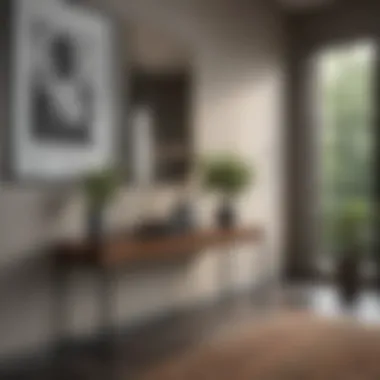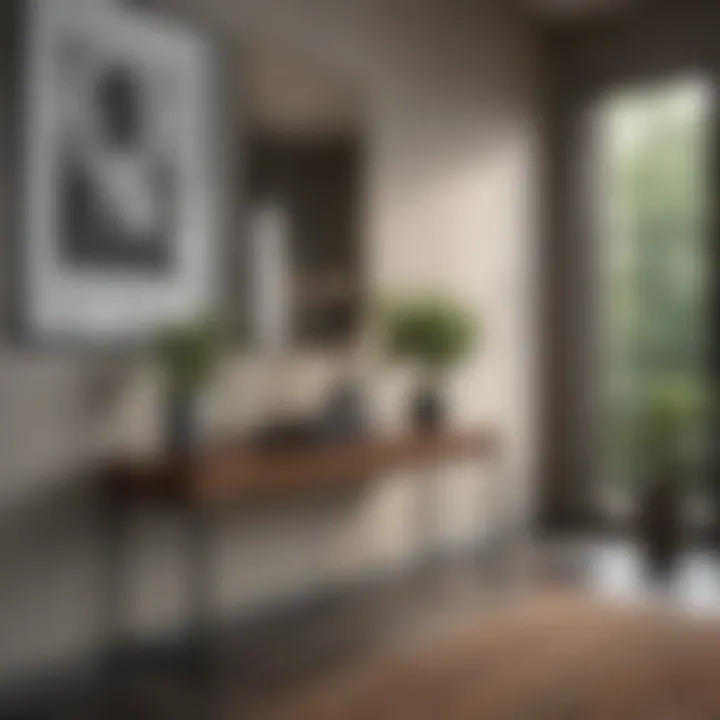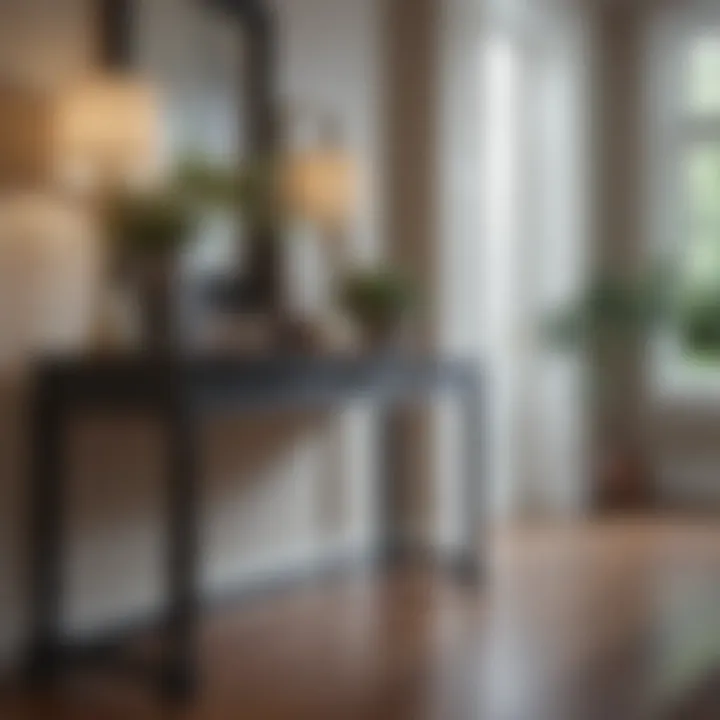Understanding Entryway Table Height in Design


Intro
When one walks through the door of a home, the entryway provides a first glimpse into the design aesthetic that unfolds within. One might think that choosing an entryway table is a simple task, but the art of selecting the right height is crucial to both aesthetic pleasure and functional utility. Often overlooked, entryway table height shapes not only the flow of the space but also contributes to the overall harmony in the interior design. This article will explore how this critical aspect of furniture design can affect the atmosphere of a home, while providing practical guidelines to tailor choices based on individual needs and spatial constraints.
Interior Design Tips
The entryway sets the tone for the entire residence, making it essential to ensure the right height of the table. Properly chosen, an entryway table invites guests to pause and admire the surroundings rather than just walk through. Here are a few pointers worth considering:
Understand the Average Heights
Ideally, entryway tables should fall between 28 to 32 inches in height. This range generally works well for most adults, ensuring that the table is practical for everyday use. You might find that some stylish console tables go a bit higher, but remember the function it has to serve: putting down keys, mail, or even a handbag. A table that invites use without becoming cumbersome is your best bet.
Functionality Meets Style
When searching for the perfect table, consider its dual role. Combining attractive design with utility can surely create a warm welcome.
- Drawers and Shelves: A table with storage can help declutter. This can create a delightful first impression without losing style.
- Surface Area: Think about how you’ll use the space. Will you need room for decor or will it primarily hold everyday items?
Space is precious, so the more efficient your choices, the better.
Balance with Surroundings
Entryway tables should align well with other furniture pieces in adjacent rooms. If your chairs or sofas are particularly low, a tall table might feel intimidating in comparison. On the other hand, a shorter table may lose its presence in a grand foyer. Consider the scale of everything around it to maintain a cohesive look. Using various heights with complementary pieces can add interest without overwhelming the space.
"The right entryway table height is not just about style; it's about creating a functional flow that welcomes and excites visitors as they enter."
Trendy Design Ideas
To elevate the appeal of your entryway table, consider these trendy design ideas:
- Layered Textures: Mix metals with wood finishes for a rich visual experience.
- Focal Points: Think about placing a striking vase or artwork on the table for eye-catching emphasis.
- Mirrored Surfaces: A mirror above the table can create a sense of spaciousness, reflecting light and enhancing depth.
Culmination
An entryway table serves more than just a decorative purpose; its height fundamentally impacts the functionality of the space. The careful selection of this piece not only enhances the overall design but also fosters a warm atmosphere that influences how one begins their experience within the home. By understanding the pivotal elements of height, utility, and surrounding decor, residents and design enthusiasts alike can curate an entryway that is as inviting as it is stylish.
Understanding Entryway Tables
Entryway tables serve more than just a function; they are a key element that sets the stage for the overall ambiance of any home. When stepping into a house, an entryway table is often the first piece of furniture that greets visitors. It can create an initial impression that echoes throughout the rest of the interior. Grabbing the right height is crucial because it influences not only aesthetics but also practicality.
Why Entryway Tables Matter
The significance of entryway tables extends beyond mere utility. They act as a transitional stage between the outside world and the intimate privacy of the home. The right height can enhance flow, giving spaces an inviting feel while also decluttering the entry. Another noteworthy aspect is how they complement other elements in the room. This ensures that the entryway doesn't feel awkward or out of place, promoting a harmonious environment.
Definition and Purpose
At its core, an entryway table is a slender, elongated piece of furniture situated in the entrance area of a home, designed not just for decor but also for practical purposes. Common names for entryway tables include console tables and hall tables. These tables can serve as a perch for keys, display space for flowers, or a resting place for bags. The versatility here cannot be overstated.
When we think of the purpose, it becomes clear why size is so significant. A table that’s too low can make the space appear cramped, whereas one that towers over the surroundings may overwhelm. Finding that sweet spot height-wise is imperative not just for the table's utility, but also for visual cohesion with the overall design aesthetic.
Historical Context of Entryway Tables
Historically, entryway tables have evolved from simple functional pieces to expressions of style and character. Originating in the 18th century, these tables were often made from opulent woods and served as a display for cherished artifacts. During this time, they were quite ornate, boasting carvings that reflected the era’s aesthetics.
Over the years, their design has adapted to changes in fashion and function. In the mid-20th century, we began to see more minimalist styles emerge. Such evolution mirrors societal shifts—an increasing appreciation for functionality without sacrificing beauty. Today, entryway tables may range from rustic charm to sleek modernity, accommodating various personal tastes while still emphasizing that all-important height relevance.
Key Insight: The historical importance of entryway tables illustrates how they are not just furniture, but narrative pieces that tell a story of personal style and broader trends in design.
Height Considerations for Entryway Tables
Choosing the correct height for an entryway table is not just a matter of aesthetics; it directly impacts functionality and user experience. A well-thought-out height can enhance the flow of the space, ensuring that it remains welcoming while being practical. This section delves into the standard height ranges and the essential factors guiding height selection.
Standard Height Ranges


Most entryway tables typically fall within a height range of 28 to 32 inches. This measurement aligns closely with standard dining table heights, making these pieces versatile for various uses. Of course, the height can vary depending on specific designs or functionalities. For example, console tables might lean toward the taller end to match with decorative elements or art pieces above them.
When selecting an entryway table, consider how its height complements the surrounding furniture and the overall room dimension. Keep in mind that while there are standards, customization based on individual needs has become increasingly common. A well-chosen height not only provides adequate space for items like keys or mail but also aligns with user comfort and accessibility.
Factors Affecting Height Selection
User Height
When discussing how user height influences table selection, it becomes clear that a one-size-fits-all approach doesn’t apply here. An entryway table should accommodate the primary users. Individuals of varying heights may find that a table set at a comfortable level allows ease of use. For instance, someone who is taller may prefer a slightly elevated table to avoid bending or stooping, thus enhancing overall comfort and accessibility.
Moreover, considering family dynamics is vital. If smaller children frequently use the space—perhaps for organizing their belongings—the height should be lower to ensure they can reach without hassle. Hence, it’s about striking a balance that caters to all household members effectively.
Room Dimensions
Room dimensions play an equally pivotal role in height selection. An expansive entry space might seamlessly accommodate a taller table, serving as a visually striking focal point. In contrast, a smaller entryway could look cramped with an imposing height, leading to an awkward feel. Thus, people need to assess their room dimensions to find that sweet spot.
Tall tables in a compact area may not only obstruct pathways but can also create visual clutter. So, while height might seem trivial at first glance, it significantly dictates how the space feels and functions.
Design Style
Design style is yet another consideration. The chosen design influences not just the height but also the entire aesthetic approach. A rustic or farmhouse entryway might favor a sturdy, lower table, while a sleek, minimalist space could benefit from a more refined and taller option. The characteristic elements of design styles—like lines, shapes, and materials—can dictate height choices as well, either reinforcing certain design principles or creating a visual dissonance.
In summary, the width of entryway table height considerations stretches beyond a mere measurement. Individual user needs, space constraints, and overarching design ethos tie into this decision. When successfully aligned, these elements produce a harmonious entryway experience that reflects functionality and beauty.
Impact of Table Height on Design Aesthetics
When considering the layout of an entryway, the height of the table plays a significant role in shaping the overall aesthetic. It's not merely about practical use; it's about how the table fits into the broader design narrative of the space. The height directly affects the proportions, scale, and symmetry within the entry, anchoring other elements, such as artwork, lighting, and decorative items.
Proportions and Scale
In interior design, proportions and scale are crucial. The height of the entryway table can either harmonize or disrupt the feel of the room. A table that is too short can make the space feel awkward and uninviting, as if the area is lacking in substance or balance. Conversely, a table that towers over the other furnishings may impose itself upon the environment, leading to discomfort or an overwhelming visual impact.
Designers often utilize the golden ratio as a guide to create pleasing proportions. For example, if a low sofa occupies the space, pairing it with a taller entryway table can create visual tension and interest. On the flip side, a short table might complement a more expansive space better, fostering a sense of openness.
Key considerations include:
- Height in Relation to Nearby Furniture: Ensuring that the table's height aligns well with adjacent furnishings enhances flow.
- Overall Height of the Room: A high ceiling might warrant taller furniture to maintain a balance, while in a cozy, low-ceilinged entry, a modestly sized table keeps things grounded.
- Personal Preferences: Finally, the individual's taste plays a vital role. One person's preference for low-slung furniture may clash with another's desire for towering pieces, making personal choice a key factor in identifying ideal height.
Visual Balance in Entry Spaces
Visual balance is all about how elements within a space interact with one another. The height of an entryway table can either contribute to a balanced look or disrupt it. Consider a tall table laden with oversized decorative vases. This arrangement can draw the eye upwards, creating a sense of whimsy and spaciousness if done right. In contrast, a low table with smaller accents can give a feeling of stability and warmth.
A well-chosen height for the entryway table can create harmonious proportions, making the space feel complete with a sense of intentional design.
When striving for visual balance, here are a few pointers:
- Layering Heights: Mixing elements of varying heights can create a dynamic entry. For instance, pairing a tall lamp on the table with short art pieces can evoke movement.
- Symmetrical vs. Asymmetrical Arrangements: Symmetry often brings a feeling of calm, while asymmetry can feel alive and spontaneous. Matching the table height to the visual rhythm desired in the space is crucial.
- Horizontal vs. Vertical Lines: The height can influence whether the entryway feels more expansive or cozy. A horizontally oriented table can make a narrow hallway feel wider, while vertical stacks of decor on a shorter table might draw attention upwards.
In essence, the height of the entryway table is not just a matter of utility—it plays a pivotal role in creating a visually appealing and cohesive space. By understanding its impact on proportions and scale, as well as visual balance, one can make more informed choices in their interior design endeavors.
Styles and Designs of Entryway Tables
The selection of styles and designs for entryway tables significantly contributes to the initial impression of a home. A well-chosen table can set a tone that resonates throughout the entire space, impacting both aesthetics and functionality. An understanding of how various styles harmonize with the rest of the room is essential for homeowners looking to maximize the entryway's potential.
Traditional vs. Contemporary Tables
Traditional entryway tables often feature rich materials and intricate details. They bring a sense of heritage, often being made from hardwood with ornate carvings or rich finishes. These tables, with their sometimes heavier appearance, might suit a classic home decor style, embodying elegance and a connection to history.
Conversely, contemporary tables focus on clean lines and minimalistic designs. Materials like metal or glass are often utilized to create a look that’s sleek and modern. This contrast in styles allows homeowners to play around with themes, creating a space that reflects their personality. The choice between traditional and contemporary designs boils down to personal taste, but understanding their fundamental differences is crucial in making an informed decision.
Material Influence on Perceived Height
Materials used in creating entryway tables greatly influence their perceived height, which in turn impacts room dynamics. The following sections will explore how different materials—wood, metal, and glass—affect both aesthetic appeal and functional aspects.
Wood


Wood, often seen as a classic choice, brings warmth and a natural feel to entry spaces. Its key characteristic is durability, allowing for a table that can withstand the wear and tear of everyday use. A beneficial aspect of wood is its versatility; it can be crafted into various shapes and sizes, making it suitable for almost any design style. However, one unique feature is its potential for modification; wood can be painted or stained to match existing decor.
One drawback of wood is its weight. A heavier wooden table may dominate a space, making it feel confined, especially in smaller entryways. Yet, the advantages often outweigh the disadvantages, especially in homes where comfort and style must coexist.
Metal
Metal tables offer a stark contrast to wood, often bringing a key characteristic of sleekness and modernity. Their benefit lies in their ability to appear airy and light, making them suitable for small spaces where every inch counts. Metal also provides a shiny surface that reflects light, contributing to an open feeling in the entryway.
Despite their many advantages, metallic tables can sometimes feel cold or uninviting, which might not be appealing for an entry area meant to welcome guests. Thus, balancing metal with softer elements is essential for creating a warm entry experience.
Glass
Glass tables are a standout when it comes to contemporary design. Their key characteristic of transparency allows them to occupy visual space without feeling bulky. This can effectively create an illusion of more space, a significant advantage in compact areas. Moreover, glass reflects light, which can make an entryway feel brighter and more open.
However, a unique feature of glass is its fragility. Homeowners with young children or pets might find this a disadvantage, as glass can chip or break more easily than wood or metal. Still, when properly cared for, glass tables can add a sophisticated touch and elevate the entire entryway aesthetic.
Understanding the styles and materials of entryway tables is not merely about decoration; it's about harmonizing the space with the home's overall design ethos. Choosing the right table type—be it traditional, contemporary, or a blend—can dictate the first impression. Furthermore, the material can influence both how the table feels physically in the space and how it appears visually, shaping the entryway experience.
Functional Aspects of Table Height
Entryway tables are not just pretty facades at the entrance of our homes; they serve multiple functions that can significantly enhance the user experience. The importance of height in this scenario cannot be overstated. The right height can usher in a level of accessibility and comfort that turns a mere table into a fully functional element in a home’s entryway. When considering this dimension, it’s vital to think through the interplay of various functions these tables can fulfill.
Accessibility and Comfort
The entryway is often the first stop for guests and residents alike. Having a table at an appropriate height makes all the difference between a welcoming space and an awkward one. Ideally, an entryway table should sit at a height that allows users to interact comfortably without strain. This means that a standard height of around 30 inches typically works well for most households. However, if your household consists of shorter or taller individuals, then you might want to adjust accordingly.
It’s important to note that accessibility isn’t just about height; it’s also about layout. This height allows for easy access to items placed upon the table, such as keys, mail, or decorative items.
"A table that feels just right can change the entire mood of an entryway. It invites use and encourages interaction."
Furthermore, comfort is a multi-faceted concern. If people in your home are frequently resting bags or packages on the entryway table, the height should accommodate those actions too. A table that’s too high may force users to stretch, while a table that’s too low might require bending down, both of which can be uncomfortable over time.
Storage Solutions in Different Heights
Height also plays a crucial role in the storage capabilities of entryway tables. Different heights can affect what you can realistically store without making those items difficult to access. For example, taller tables may have a larger surface area, creating a space to stack items, but they may not be ideal for stashing things inside. On the flip side, lower tables could include drawers or shelves that are easily reachable, effectively concealing shoes, bags, or other items you might not want on display.
When selecting a design, think about the functional aspects:
- If you opt for a higher table: Consider attaching hooks or racks along the sides to enhance storage utility.
- For lower tables: Shelving options could be beneficial, allowing for an organized look while keeping essentials within reach.
Customization and Adaptation
When it comes to crafting a welcoming entryway, customization and adaptation of table height play pivotal roles. Homeowners and interior design enthusiasts often overlook the significance of adjusting table height to meet personal needs and spatial challenges. This approach not only personalizes an entryway but also significantly enhances its functionality and aesthetic appeal.
Customization involves tailoring the furniture to fit the specific dimensions of the space as well as the intended use. For example, some may find that a standard table height of about 30 inches feels too high or low for them, especially if they are shorter or taller than average. Adjusting the table height ensures that it fulfills both practical and visual functions.
Here are some benefits to consider regarding customization:
- User Comfort: A table that matches a user's height enhances comfort. Imagine a tall individual bending awkwardly every time they want to place their keys on a table that is too short.
- Room Flow: Adapting the table’s height can help in maintaining smooth room circulation. A table that is too tall in a narrow space may obstruct passageways, creating a cluttered atmosphere.
- Design Cohesion: Height can enhance or detract from the overall design coherence. A well-sized table complements other furnishings, providing harmony in design, while a mismatched height can disrupt the visual flow.
Adjustable Entryway Tables
Adjustable entryway tables have gained traction in modern interior design due to their versatility. These tables can be modified in height to suit varying needs, making them suitable for homes with diverse occupants. For instance, families with young children might need a lower table for easy access to essentials, while adults might prefer a higher setting for practicality.
Moreover, many adjustable tables feature a sleek design that does not compromise on aesthetics. For example, a contemporary adjustable table made from tempered glass might easily transition from a casual height to a more formal one when entertaining guests. Such tables often come with mechanisms that allow for smooth adjustments, ensuring user-friendliness.
Homeowners can reap several advantages:
- Increased Usability: A table that can adjust to various heights meets the specific needs of all family members, fostering greater usability.
- Dynamic Styling: The flexibility in height makes it easier to renovate or re-arrange the space for different gatherings or occasions without needing a new piece of furniture.
- More Practical Storage: These tables can often double as extra space for storage solutions, accommodating additional items below or above.
Creating Built-in Solutions
Incorporating built-in entryway tables into the design of a home takes customization a step further. Built-in solutions typically utilize available space to provide tailored, functional design without the clunky look of added furniture. For instance, an alcove can become an inviting entryway nook with a table perfectly shaped and sized to fit its dimensions.
This approach allows homeowners to maximize space without sacrificing style or accessibility.
Some elements to consider when creating built-in solutions include:


- Space Planning: Thoughtful planning enables designers to allocate space efficiently, integrating the table seamlessly into the overall layout of the home.
- Material Consistency: Using the same materials as the walls or other built-in elements creates a cohesive look that enhances the design.
- Multi-functional Features: A built-in table can double as seating or desk space, providing additional utility in smaller homes. This aspect can be particularly beneficial in tight urban quarters.
As highlighted, customization and adaptation of entryway table height is far from trivial. Rather, it is fundamental for crafting functional and aesthetically pleasing spaces that reflect individual needs and style. Considering adjustable options and the possibility of built-in solutions opens a world of possibilities, allowing unique entries that cater to diverse lifestyles.
Integrating Tables within Entryway Design
An entryway table serves as more than just a piece of furniture; it acts as the first glimpse into a home’s personality and style. Consequently, integrating these tables into the design of an entryway is not merely about placement but about crafting a narrative that speaks to the homeowner's intention. When one considers the integration of tables, several elements come to the forefront, influencing not just visual appeal but also functionality, flow, and comfort.
Complementing Existing Decor
To harmonize an entryway table with existing decor, the first step is understanding the overarching theme of the space.
- Color Coordination: Ensure that the table’s color complements the wall paints and other furniture. A stark contrast might work in some spaces, but a more unified palette often feels more inviting.
- Style Match: The table should echo the style of surrounding furniture. For instance, if an entryway is adorned with classic wooden pieces, incorporating a vintage-styled table can create a seamless look. Conversely, a glass table might clash in a traditional setting but shine in a modernist or minimalist design.
- Textures and Materials: Introduce depth through mixing textures. A wooden table paired with a wicker basket or a metallic lamp can provide tactile diversity that enhances the aesthetic experience.
In this harmonious blend, the entryway transforms into a welcoming hand of friendship, enticing visitors to come further into the interiors. The visual flow created by attention to detail can elevate overall design coherence.
Creating Focal Points
A well-placed entryway table can serve as a synthesis of style and function. Its placement can draw the eye and act as a focal point, seamlessly guiding the flow of the space.
- Strategic Positioning: Position a table at the perfect height to catch attention without obstructing pathways. Ideally, it should coexist with other elements in the entryway without appearing crowded.
- Decorative Accents: Utilize the tabletop as a canvas for decorative touches such as a large vase with fresh flowers or an eye-catching sculpture. These elements can create immediate visual interest that invites exploration.
- Lighting Considerations: Placing a small lamp on the table or positioning it near a light source can enhance its prominence in the entryway. Lighting plays a crucial role in making the table stand out, beckoning guests as they step inside.
In essence, the integration of entryway tables into design not only enhances the aesthetic appeal but also contributes to a sense of identity for the space. When done thoughtfully, it affirms the homeowner’s style and provides functionality that accommodates daily living.
A well-integrated entryway table is the silent host, presenting a warm welcome and ensuring every arrival feels significant.
Case Studies and Examples
Exploring case studies and examples sheds light on the practicality and creativity inherent in choosing the right entryway table height. This segment is not just about does it fit but rather how the height can transform the overall aesthetic and functionality of a space. Real-life applications provide tangible insights, allowing homeowners and interior design enthusiasts to picture their own spaces more clearly.
Successful Implementation in Modern Homes
In many modern homes, entryway tables serve as more than just a catch-all for keys and mail. They are central pieces that can set the tone for the decor throughout the house. Take, for instance, a chic urban apartment featuring a sleek, narrow entryway table, standing at 30 inches. This particular height aligns perfectly with the surrounding aesthetic, allowing the table to provide a visual extension of the walls without overpowering the space.
Consider a family home in the suburbs that opts for an entryway table around 32 inches tall. This height accommodates taller family members while also securing a comfortable browsing level for younger kids. Such tables often double as collaborative surfaces for family activities. Displaying treasured photographs or seasonal decorations at this height can make a significant impact on visitors, beckoning them to engage with the space immediately upon entry.
A third example can be found in a rustic farmhouse style where a reclaimed wood table at 28 inches blends seamlessly with vintage decor. The thoughtful height here enhances the cozy appeal, encouraging guests to lean in closer, admire the textures, and feel welcomed. It demonstrates how height can cultivate not just aesthetics but also the emotional reception of a home, bridging gaps between practicality and comfort.
Missteps to Avoid
When it comes to entryway tables, not all that glitters is gold. Height has its share of pitfalls, especially when design isn’t paired with functionality. One common mistake is selecting a table that’s too short. Imagine a lavish foyer with a grand chandelier overhead, paired with a table too low—this discrepancy can just look plain awkward. The feeling becomes counterproductive to the desired entry experience and creates a visual disconnect.
Another misstep is the temptation to prioritize style over user experience. For instance, a homeowner might fall in love with a sculptural table at an eye-catching 36 inches. However, if this height doesn’t consider who will be using it and the overall space, accessibility issues may arise. It can easily become cumbersome or hard to navigate, especially in a bustling family environment.
Finally, neglecting to account for the surrounding decor may lead to issues of scale. A towering height that overshadows wall art or a mirror can create tension rather than balance within the entryway. To maintain harmony with existing decor, it’s crucial to consider not just the table’s height but its compatibility with the rest of the space.
"Misjudging the height of an entryway table can turn an inviting space into an awkward one, stripping away the essence of welcoming a guest."
In summary, examining instances of successful implementation alongside common missteps provides invaluable lessons. It's not just about the table; it's about how it interacts with the home and the people who live in it. Adjusting the height of an entryway table is essential for ensuring that the aesthetic contribution aligns effortlessly with both function and user experience.
The End on Table Height Importance
In the realm of interior design, every detail counts, and the entryway table height is no exception. It serves as a critical junction where aesthetics meet functionality. The right height not only enhances the overall look of the space but also impacts usability. There’s an art to selecting a size that caters to both form and function. An ideal entryway table balances elegance with practicality, making a statement in any home.
When considering table height, one must delve into various factors such as the intended use of the table, the surrounding decor, and, importantly, the users. For instance, a petite table may complement a hallway adorned with wall art, while a more substantial piece could serve as a focal point in a grand entrance. This choice can create a seamless flow within the space and contribute significantly to the perceived comfort and usability.
Furthermore, an adequately scaled table invites interaction. It provides a suitable height for placing keys, mail, or decorative elements without causing awkward stretches or strains. A table too high or too low can disrupt the ease of movement in the entryway, creating an atmosphere that feels either cramped or unwelcoming.
Ultimately, understanding the nuances of table height equips homeowners and design enthusiasts to make thoughtful choices that resonate with their lifestyles. A well-chosen entryway table enhances not just the function of a space but also reflects the character of its inhabitants.
Summary of Key Insights
- Functionality Over Aesthetics: A table’s height should primarily cater to regular usage needs, ensuring comfort and ease.
- Proportions Matter: The relationship between the table height and other furniture is crucial for maintaining visual balance in the entryway.
- User Consideration: Customizing height depending on the primary users, whether tall adults or smaller children, can vastly improve accessibility and comfort.
- Aesthetic Cohesiveness: Selecting an entryway table that corresponds with architectural elements and other furnishings helps create a harmonious environment.
Future Trends in Entryway Design
The trend in entryway design is steadily shifting towards versatility and personalization. Homeowners today are increasingly looking for pieces that not only look good but serve multiple purposes. Among these emerging trends, here are a few noteworthy ones:
- Multifunctional Furniture: More homeowners are opting for tables with built-in storage. These pieces not only save space but offer practical solutions for everyday items.
- Adjustable Heights: As comfort takes precedence, adjustable tables are gaining popularity. This allows users to customize the height according to their preference or needs, promoting a more inclusive design.
- Sustainable Materials: There’s a growing demand for eco-friendly materials in furniture design. Using reclaimed wood or low-impact finishes reflects a commitment to sustainability, which is attractive to modern consumers.
- Smart Features: With technology integration on the rise, we might see entryway tables equipped with charging ports and modular configurations to accommodate evolving tech needs.
This evolving landscape encourages creativity and caters to a broad spectrum of tastes. As design continues to evolve, paying attention to the height and functionality of entryway tables will remain pivotal.







